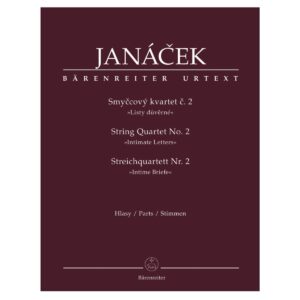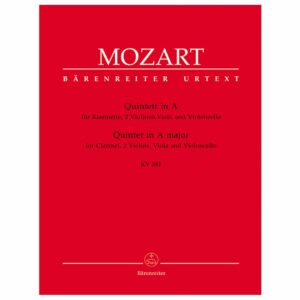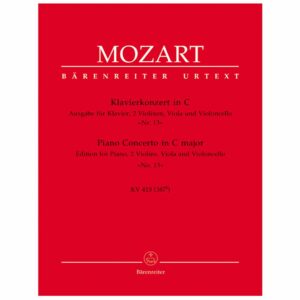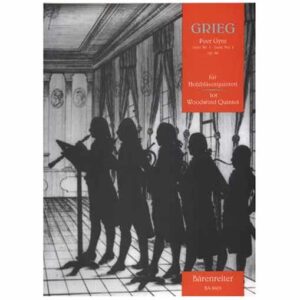ISOLUTION
-
-
Bach – Six Suites For Cello Solo BWV 1007-1012 German
A unique edition – all readings at a glanceThis new edition, in contrast to the array of Bach Cello Suite publications available today, has made use of all the five sources which have come down to us. The basis for this edition is the most reliable of the sources, the manuscript copy in the hand of Anna Magdalena Bach. All variant readings from the four other sources are clearly laid out for performance. Cellists now have the possibility of rendering performances based on just one of the five sources as well as the option of combining the sources in a mixed version.
Content:
Composer / Author: Bach, Johann Sebastian
Suite I BWV 1007
Instrumentation: Cello
Composer / Author: Bach, Johann Sebastian
Suite II BWV 1008
Instrumentation: Cello
Composer / Author: Bach, Johann Sebastian
Suite III BWV 1009
Instrumentation: Cello
Composer / Author: Bach, Johann Sebastian
Suite IV BWV 1010
Instrumentation: Cello
Composer / Author: Bach, Johann Sebastian
Suite V BWV 1011
Instrumentation: Cello
Composer / Author: Bach, Johann Sebastian
Suite VI BWV 1012
Instrumentation: Cello
Composer / Author: Bach, Johann Sebastian
Appendix: Suite V in Standard Tuning BWV 1011
Instrumentation: Violoncello€59,00€63,00Διαθέσιμο σε 1-3 ημέρες
-
Mendelssohn – Concerto In E Minor Op.64 1844-1845
Mendelssohn Bartholdy, Felix
Concerto for Violin and Orchestra in E minor Op.64
Early version 1844 and late version 1845
Set of Two Books ( Piano Reduction & Violin Part)
In 1838 Felix Mendelssohn wrote to the violin virtuoso Ferdinand David informing him that he was working on a violin concerto “… the opening theme, one in E minor runs through my head and it gives me no peace”; the concerto in the state described by Mendelssohn to David was never published in a performing edition – it was only rediscovered in 1988.
One would think that such an important work would be adequately represented in modern editions true to the sources. Alas not even the score used today represents the orchestral parts Mendelssohn saw to print in 1845, but one heavily edited in the 1860s by Julius Rietz for the Mendelssohn Complete Edition.
For the Bärenreiter Urtext edition, the Mendelssohn specialist R. Larry Todd has edited both the original version of the concerto as well as the later version known today.
The first version of the concerto calls for the soloist to perform the orchestral tuttis , contains a shorter cadenza by Mendelssohn, many solo violin pitches in different octaves, passages with different orchestral scoring and many many surprises regarding articulation and dynamics.
The later version goes back to the first edition orchestral parts published in 1845 and the piano reduction sanctioned by Mendelssohn.
Todd makes use of all known sources including the letters between Mendelssohn and David as well as Mendelssohn and the original publishers where general schemes as well as specifics of articulation were exchanged.
This first ever Urtext edition of one of the most popular violin concertos in the repertoire finally gives performers the opportunity of playing just what Mendelssohn wrote.
Editor: Todd, R. Larry
Violin PerformancePart: Wulfhorst, Martin
Score Pages: 89
Violin Part Pages: 32×2
Language: English, German
Publisher: Bärenreiter€42,30€47,00Mendelssohn – Concerto In E Minor Op.64 1844-1845
€42,30€47,00Διαθέσιμο σε 1-3 ημέρες
-
Janacek – String Quartet N.2, “Intimate Letters”
Janáček, Leoš – String Quartet Nr.2 “Intimate Letters”
– Urtext based on the “Critical Complete Edition of the Works of Leos Janácek”
– With a foreword by Milos Stedron (Cz/Eng/Ger)
– Autograph sketches used as the primary source
Janácek’s 2nd String Quartet, “Intimate Letters”, is regarded as a highlight of the modern string quartet literature. It was written during the composer’s last year of life, between 29 January and 19 February 1928, inspired by the ageing Janácek’s exceptional love for Kamila Stösslová. The Moravian Quartet devoted themselves to this impressive work; Janácek attended a total of three of their rehearsals in May and June 1928. This had several consequences, including his abandoning his original idea of using a viola d’amore.
After Janácek’s unexpected death (12 August 1928) the uncertain genesis of the work became the greatest problem of the “Intimate Letters”: the surviving copies were not definitively authorised.
The editors of this new edition have reverted to Janácek’s autograph sketches as the main, most reliable source and using these as a basis, have reconstructed the work as it stood at the point of Janácek’s death. The musical text, taken from the “Critical Complete Edition of the Works of Leos Janácek” (Vol. E/4), therefore contains clear differences in comparison with older editions.
Editor: Faltus, Leoš / Štedron, Miloš
Instrumentation: Violin (2), Viola, Violoncello
Language: English, Czech, German
Publisher: Bärenreiter
€22,50€25,00Janacek – String Quartet N.2, “Intimate Letters”
€22,50€25,00Διαθέσιμο σε 1-3 ημέρες
-
Debussy – Suite bergamasque
State-of-the-Art Bärenreiter quality Urtext
Performer information on Aesthetics i.e. pedalling, tempo, articulation, dynamics
Critical report (Eng.) and Facsimile
Claude Debussy’s Suite bergamasque was first published in 1905 by the French publisher Fromont, but the suite’s origins go back to the early 1890s when it was first under contract with the publisher Choudens. By the time of the suite’s publication, nearly 15 years had transpired and the originally three-movement suite had evolved into one with four movements with different titles and the work was issued by a publisher with whom Debussy had complex relations.
The extant 1st proofs to the first edition, corrected by Debussy, clearly show his excision of dozens of bars and reveal numerous textural alterations. In 1909 at the earliest, Fromont re-engraved the suite and added many accidentals – in particular in the Passepied – thus altering the harmony. This later engraving has been the basis for all modern editions although no justification for the re-engraving or the resulting modifications can be traced back to Debussy.
Regina Back’s Urtext edition clearly lays out the development of the suite, documents the various reprints and the changes to them, and offers unique insights into the title of the suite and the individual movements.
Bärenreiter’s new edition is based on the first edition corrected by Debussy – with its original harmony – and offers the later alterations as the small print in the volume.
Einführung
Introduction
Introduction
Faksimiles / Facsimiles / Facsimiles
Critical Commentary€10,50€11,50Debussy – Suite bergamasque
€10,50€11,50Διαθέσιμο σε 1-3 ημέρες
-
Debussy – Deux Arabesques
Close on the heels of Regina Back’s critical edition of Debussy’s Children’s Corner come the equally popular Deux Arabesques in the definitive Urtext performing edition.
These two jewels of the piano literature were first published in 1891 and made available at the time in a relatively small print run of 300 copies. In 1903 the French publisher Durand attempting to capitalize on Debussy’s quickly growing fame published the Arabesque No.1 in an advertisement in Le Figaro and between 1904 and the new engraving with corrections and revisions in 1912 more than 50,000 copies were sold!
Bärenreiter’s new Urtext edition while drawing on all known sources, documents the geneses of the compositions until 1912 and the new edition is based on this corrected 1912 re-engraving.
State-of-the-Art Bärenreiter quality Urtext
Performer information on Aesthetics i.e. pedalling, tempo, articulation, dynamics
Critical report ( Eng. ) and Facsimile…
Einführung
Historisches
Der Begriff “Arabeske”
Ästhetik und Aufführungspraxis
Zur Edition
Die Quellen
Faksimile
Critical Commentary€7,00€7,80Debussy – Deux Arabesques
€7,00€7,80Διαθέσιμο σε 1-3 ημέρες
-
Mendelssohn – 6 Kinderstucke Op.72& 7 Charakterstk Op.7
Seven Character Pieces op. 7 / Six Children’s Pieces op. 72
Two of Mendelssohn’s famous piano albums, with pieces of easy to medium level of difficulty
Urtext edition reflecting the latest research findings
Different versions are taken into consideration
Critical Commentary and detailed foreword (Ger/Eng)
The “ Charakterstücke op. 7” and “ Kinderstücke op. 72” are Mendelssohn’s most popular piano albums besides his “Lieder ohne Worte ” and the “Variations sérieuses op. 54”. Robert Schumann described the character pieces as an “interesting contribution to the development” of the “masterful youth”.
The compositions mostly dating from 1827, are essentially the result of his lessons with Carl Friedrich Zelter in Berlin. The teacher encouraged his pupil to immerse himself in the strict style of old music”, in particular Johann Sebastian Bach, but at the same time, as he himself said, confidently allowed Mendelssohn to dream of “dragons and goblins”.
In the 19th century, learning the piano was regarded as a highly desirable accomplishment. The demand for piano lessons for children led rapidly to the development of a repertoire suitable for this age-group. Albums for children were particularly popular around the mid-19th century and were popular presents for children’s birthdays, Christmas and other occasions.
Mendelssohn’s “ Kinderstücke op. 72” were published in London in 1847, the year of his death, under the title “Christmas Present for His Young Friends”.
The edition contains both piano cycles in the versions published in the first edition, and an extensive appendix also includes variants and early versions which survive in different autograph manuscripts
Content
Vorwort / Preface
Sieben Charakterstücke Opus 7 (Fassung des Erstdrucks / Version from the First Edition):
Sanft und mit Empfindung
Mit heftiger Bewegung
Kräftig und feurig
Schnell und beweglich
Ernst und mit steigender Lebhaftigkeit
Sehnsüchtig
Leicht und luftig
Sechs Kinderstücke Opus 72 (Fassung des Erstdrucks / Version from the First Edition):
Allegro non troppo
Andante sostenuto
Allegretto
Andante con moto
Allegro assai
Vivace
Anhang / Appendix:
I. Autographe Fassungen der Charakterstücke Opus 7 Nr. 1, 2 und 4 / Autograph Versions of the Charakterstücke Opus 7 nos. 1, 2 and 4:
Andante
Allegro vivace
Con moto
II. Stücke aus den Notenalben für Eduard und Lilli Benecke (1842) / Pieces from the Albums for Eduard and Lilli Benecke (1842):
1. Aus dem Notenalbum für Eduard Benecke / From the Album for Eduard Benecke:
Allegretto (op. 72 Nr. 3, Frühfassung / Early Version)
Andante
Allegro assai (op. 72 Nr. 5, Frühfassung / Early Version)
Sostenuto [Erstausgabe / First Edition]
2. Aus dem Notenalbum für Lilli Benecke / From the Album for Lilli Benecke:
Allegretto (op. 72 Nr. 6, Frühfassung / Early Version)
Andante con moto (op. 72 Nr. 4, Frühfassung / Early Version)
Andante sostenuto (op. 72 Nr. 2, Frühfassung / Early Version)
Con moto (op. 72 Nr. 1, Frühfassung / Early Version)
Critical Commentary€23,50€26,10Διαθέσιμο σε 1-3 ημέρες
-
Debussy – Pour Le Piano
State-of-the-Art Bärenreiter quality Urtext
Performer information on Aesthetics i.e. pedalling, tempo, articulation, dynamics
Critical report (Eng.) and Facsimile
Little is known about the origins of Debussy’s Pour le piano, only that the second movement Sarabande was written in 1894 and that the autograph carries the clear inscription »1901«.
As with the Suite bergamasque, Pour le piano was published first by Fromont in 1901, although Debussy did not grant him the full rights to the composition until 1905. This delay had most certainly to do with Debussy’s efforts to have Fromont transfer the rights to Pelléas et Mélisande to his new exclusive publisher Durand; in other words, Fromont was to own Pour le piano only if Durand owned Pelléas.
Bärenreiter’s new critical scholarly edition edited by Regina Back relies on all known sources, documenting the genesis of the composition, provides a detailed Critical Commentary and enlightens with its text passages on performance practice and Debussy’s piano music.
Einführung:
Entstehungs- und Pubikationsgeschichte
Zum Werk
Ästhetik und Aufführungspraxis
Zur Edition
Die Quellen
Übersetzung der Spielanweisungen
Introduction:
Genesis and Publicatin History
The Work
Aesthetics and Performance Practice
Notes on the Edition
The Sources
Translation of Performance Instructions
Introduction:
Genèse et historique de la publication
L’Œuvre
Esthétique et traditions d’exécution
Notes sur l’edition
Sources
Faksimile / Facsimile / Facsimile
Anhang / Appendix / Appendice
Critical Commentary€8,40€9,30Debussy – Pour Le Piano
€8,40€9,30Διαθέσιμο σε 1-3 ημέρες
-
Rossini – The Barber of Siviglia
With the arrangements for the woodwind quintet begins a series of arrangements for instrumentation which, due to the variety of sounds and possible variations of its five different instruments, seems predestined to make works of this type accessible to chamber music as well.This series follows in the tradition of countless contemporary arrangements, such as the Harmoniemusic, created in part by the composers themselves, only now for a scoring brought to life by Czech-born French composer Anton Reicha in the early 19th century and only achieved its current level of virtuosity with the invention of the valve horn.€18,00Διαθέσιμο σε 1-3 ημέρες
-
Barenreiter Mozart – Symphony for woodwind quintet in G minor, K. 550
The arrangement of Mozart’s Symphony in G K. 550 includes all four movements and is ideally suited to the five instruments – flute, oboe, clarinet, horn and bassoon – of the classical wind quintet. The edition includes a reference score and parts.€35,70€39,70Διαθέσιμο σε 1-3 ημέρες
-
€38,50
Διαθέσιμο σε 1-3 ημέρες
-
Mozart – Sinfonia concertante in E flat major KV Anh. I/9 (297b)
We know from letters to his father that during his stay in Paris in 1778 Mozart wrote a Sinfonia concertante for flute, oboe, horn, bassoon and orchestra for a quartet of wind soloists who were also there – Mozart’s autograph was lost, the work is missing.In the 19th century, a copy of a Sinfonia concertante in E-flat for oboe, clarinet, horn, bassoon and orchestra appeared, for which Mozart’s authorship was claimed and which – despite the different instrumentation of the wind quartet – was linked to the Sinfonia concertante, which was believed to be lost has been brought. For a long time, the work was considered genuine, but vehement doubts have been raised about its authenticity for around 25 years, which relate not only to the scoring of the soloist quartet but also to the orchestral parts.Robert Levin’s reconstruction is based on the assumption that the setting of the solo parts is genuine in its germ and has been re-instrumented by a foreign arranger (flute to oboe, oboe to clarinet). Levin considers the orchestral parts to be fake. In his reconstruction, Levin restored the instrumentation of the soloist quartet with flute, oboe, horn and bassoon mentioned in Mozart’s letters and rewrote the orchestral parts. Thorough analysis of Mozart’s style and an intimate knowledge of Mozart’s writing enabled Levin to take the risk of this reconstruction. It is available as rental material (BA 7137) and is part of the popular repertoire of solo wind instruments.€25,00€25,60Διαθέσιμο σε 1-3 ημέρες
-
-
Mozart – Quintet in A major KV 581 “Stadler Quintet”
Pages; 8/8/8/8/7€17,80€19,80Mozart – Quintet in A major KV 581 “Stadler Quintet”
€17,80€19,80Διαθέσιμο σε 1-3 ημέρες
-
Mozart – Concerto No. 11 in F major K. 413
“Mr Kapellmeister Mozart hereby announces to the distinguished audience the publication of three new piano concertos. These 3 concerts, which can be performed with a large orchestra with wind instruments or only a Quattro, namely with 2 violins, 1 viola, and a violoncello, will not be performed until the beginning of April this year. J. (1783) come to light …” This advertisement shows that Mozart wanted to keep the accompaniment apparatus flexible in the piano concertos KV 413-415 (and KV 449, as we know from a letter from Mozart to his father). In addition to the large orchestral scoring, a piece of pure chamber music scoring with simply scored strings is also possible.The edition takes this into account: on the one hand, it enables the performance of the works in the large orchestral sound form, but on the other hand, enriches the attractive group of works of chamber music with piano.€31,50Διαθέσιμο σε 1-3 ημέρες
-
Mozart – Concerto No. 14 in E flat major KV 449
“Mr Kapellmeister Mozart hereby announces to the distinguished audience the publication of three new piano concertos. These 3 concerts, which can be performed with a large orchestra with wind instruments or only a Quattro, namely with 2 violins, 1 viola, and a violoncello, will not be performed until the beginning of April this year. J. (1783) come to light …” This advertisement shows that Mozart wanted to keep the accompaniment apparatus flexible in the piano concertos KV 413-415 (and KV 449, as we know from a letter from Mozart to his father). In addition to the large orchestral scoring, a piece of pure chamber music scoring with simply scored strings is also possible.The edition takes this into account: on the one hand, it enables the performance of the works in the large orchestral sound form, but on the other hand, enriches the attractive group of works of chamber music with piano.€31,50Διαθέσιμο σε 1-3 ημέρες
-
Mozart – Piano Concert In C Maj Kv 415
“Mr Kapellmeister Mozart hereby announces to the distinguished audience the publication of three new piano concertos. These 3 concerts, which can be performed with a large orchestra with wind instruments or only a Quattro, namely with 2 violins, 1 viola, and a violoncello, will not be performed until the beginning of April this year. J. (1783) come to light …” This advertisement shows that Mozart wanted to keep the accompaniment apparatus flexible in the piano concertos KV 413-415 (and KV 449, as we know from a letter from Mozart to his father). In addition to the large orchestral scoring, a piece of pure chamber music scoring with simply scored strings is also possible.The edition takes this into account: on the one hand, it enables the performance of the works in the large orchestral sound form, but on the other hand, enriches the attractive group of works of chamber music with piano.€29,50Διαθέσιμο σε 1-3 ημέρες
-
Mozart – Piano Concert In A Maj Kv 414
“Mr Kapellmeister Mozart hereby announces to the distinguished audience the publication of three new piano concertos. These 3 concerts, which can be performed with a large orchestra with wind instruments or only a Quattro, namely with 2 violins, 1 viola, and a violoncello, will not be performed until the beginning of April this year. J. (1783) come to light …” This advertisement shows that Mozart wanted to keep the accompaniment apparatus flexible in the piano concertos KV 413-415 (and KV 449, as we know from a letter from Mozart to his father). In addition to the large orchestral scoring, a piece of pure chamber music scoring with simply scored strings is also possible.The edition takes this into account: on the one hand, it enables the performance of the works in the large orchestral sound form, but on the other hand, enriches the attractive group of works of chamber music with piano.€29,50Διαθέσιμο σε 1-3 ημέρες
-
Meyerbeer – Quintet in E flat major
The source-critical edition is the first edition of the clarinet quintet, which was lost after the Second World War; it was only recently found in the estate of the clarinettist Carl Bärmann. Meyerbeer wrote this quintet in Vienna in 1813 for his friend, the celebrated clarinettist Heinrich Bärmann, to whom CM von Weber also dedicated a number of compositions. The virtuosic treatment of the clarinet is new and unusual for the time. Meyerbeer allows them to emerge clearly from the strings, almost reaching the limits of their technical possibilities. Meyerbeer’s clarinet quintet enriches the already sparse literature for clarinet in the field of chamber music in the 19th century. The scientifically critical edition makes this masterpiece accessible for practice for the first time. In addition to the pure musical text, it offers a detailed foreword that introduces the history of the work, as well as a critical report. Dieter Klöcker set up the voices for practical use.€28,50Διαθέσιμο σε 1-3 ημέρες
-
Haydn/Salomon – Symphony in D major Hob. I:104 “Londoner”
A good 200 years ago in London, Johann Peter Salomon made five-part arrangements for flute, string quartet and piano ad libitum of Haydn’s 12 London symphonies. The distribution of the arrangements was enormous. Reprints in England and other European countries attest to their popularity. Salomon had been able to close a gap in the chamber music repertoire.Christopher Hogwood presents here a new edition of the arrangement of Symphony No. 104. The basis is Salomon’s original manuscript, which was found a few years ago.€38,00Διαθέσιμο σε 1-3 ημέρες
-
Haydn/Salomon – Symphony Quintetto in C major Hob. I:97
Only a few years after Joseph Haydn’s twelve “London” symphonies were written, Johann Peter Salomon (1745–1815) published ad libitum arrangements of these works for flute, string quartet and piano for the first time. Numerous reprints in Europe indicate the extraordinary success of these arrangements in the 19th century. Based on Salomon’s original manuscript, Christopher Hogwood now presents a new practical edition of the arrangement of Symphony No. 97. This and the three six-part arrangements that have already been published enrich the chamber music repertoire and are likely to be as popular today as they were in the 19th century.€38,00Διαθέσιμο σε 1-3 ημέρες
-
Grieg – Peer Gynt Suite No. 1 Op. 46
Since Grieg’s Peer Gynt Suite No. 1 was first performed in 1876, this work has become one of the most performed of the Romantic period. It was not long before the suite was arranged for other ensembles. The present arrangement of four movements for the woodwind quintet does justice to Grieg’s sound world by bringing out the subtle nuances of the five very different instruments. Included, of course, are “Morning,” “Aase’s Death,” “Anitra’s Dance,” and the suite’s centrepiece, “In the Hall of the Mountain King.”€32,50Διαθέσιμο σε 1-3 ημέρες
-
Dvorak – String Quintet in G major op. 77
The Quintet in G major for two violins, viola, cello and double bass is a work from the time of Dvorak’s first rise; the higher opus number was later assigned to the piece by the publisher Simrock. The quintet was composed in 1875 as a competition composition in chamber music. This piece by Dvorak won in the competition organized by the music department of the Umelecka beseda (cultural society). For the 1888 print edition, the composer revised the original five-movement version of the quintet, emphasizing one slow movement. The volume is part of the first complete critical edition of the works of A. Dvorak.€19,70€21,90Dvorak – String Quintet in G major op. 77
€19,70€21,90Διαθέσιμο σε 1-3 ημέρες
-
Dvorak – String Quintet in E flat major op. 97
The piece, composed with the string quartet in F major in Spillville, America, during the summer holidays of 1893, is one of the fruits of Dvorak’s stay in America. Like the other works from this period, the Quintet in E flat major is influenced by elements of American music, the pentatonic scale and black folklore. The volume is part of the first complete critical edition of the works of A. Dvorak.€19,70€21,90Dvorak – String Quintet in E flat major op. 97
€19,70€21,90Διαθέσιμο σε 1-3 ημέρες



























for 2 Violins and Orchestra
(Piano Reduction)
Editor: Šolc, Karel
Score Pages: 61
Violin Part Pages: 16 x 2
Language: English, German, Czech
Publisher: Bärenreiter